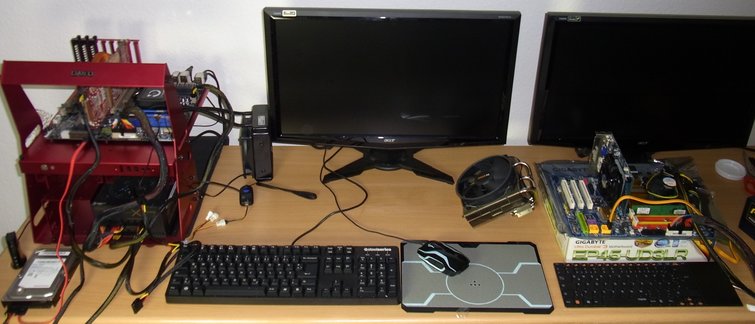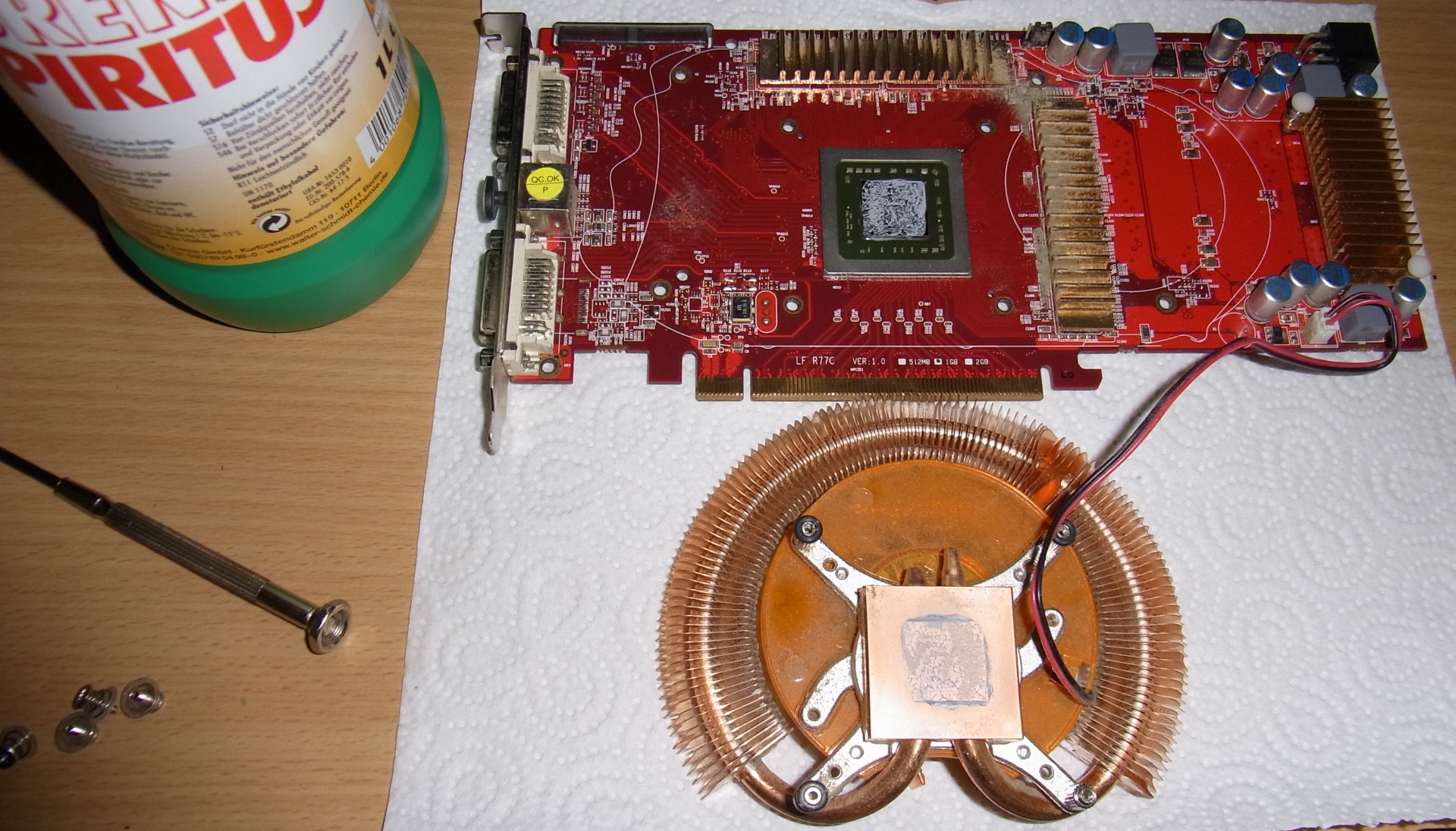Why four different measurements for the charts?
At the time, we had collected and evaluated many suggestions and wishes of our readers in the forum, which led us in the end to the decision to use all thermal conductive pastes with both water cooling and air cooling using two different assembly variants (contact pressure!) and of course also in use on a graphics card.
Why are we separating this now? On the one hand, there are the (compact) water coolings, in which the temperatures on the heat sink should generally remain well below 60°C, the good air coolers with a very solid fastening and the resulting high contact pressures of the radiator floor on the heat spreader, as well as the "cheap" budget coolers with simple clamping fasteners or Push pins and a little less contact pressure, where you can quickly reach higher temperatures.
Depending on the viscosity and composition, not all pastes are always equally suitable for all applications and are also rarely always equally manageable for newcomers. We also want to include a point in our charts, but as a subjective evaluation, of course.
 Unchanged measuring station in the laboratory since 2013
Unchanged measuring station in the laboratory since 2013
Let's first take a look at the systems used for measurements with the CPUs, which for many reasons have not changed over the years. On the one hand, a plausibility test has shown that, on the one hand, the measured distances between the individual pastes do not change or only marginally change on the latest hardware, and on the other hand, the sensors of the older CPUs provide significantly more accurate values than the DTS of the current CPUs.
We can therefore measure the exact temperature below the heat spreader, which is extremely important and indispensable for an objective evaluation. Using Tcase instead of Tcore is always the more accurate solution. What always excites us is the long-term durability of all used comnpons, even if we have of course stored both CPUs, as well as the graphics card and the motherboard twice in the archive in case of cases. the only thing that really needed to be replaced was the power supply after three years.
| Test 1 – Compact water cooler | |
|---|---|
| Cooler used |
Corsair H80i Compact Water Cooling |
| Fan |
Original fan of the H80i, powered by 7 volts unregulated. |
| Cpu |
AMD FX 8350 |
| Motherboard |
Asus 990FX Sabertooth |
| Test 2 – Air cooler with own backplate and solid screwing |
|
|---|---|
| Cooler used |
Be Quiet Shadow Rock |
| Fan |
Original fan of the shadow skirt, speed set to 70% fixed |
| Cpu |
Intel Core2Quad Q6600 Q0 x 2.66 GHz |
| Motherboard |
Gigabyte UP45-UD3LR |
| Review 3 – Intel Boxed Cooler with Push Pins |
|
|---|---|
| Cooler used |
Intel Boxed Cooler |
| Fan |
Original fan, speed set to 80% fixed |
| Cpu |
Intel Core 2 Duo E6850 |
| Motherboard |
Gigabyte UP45-UD3LR |
Use on the graphics card
This is a slightly more sensitive issue and we will generally exclude electrically conductive pastes and liquid metal products from the test for safety reasons. Since the GPUs do not use a heat spreader, but the chip is located directly on the heat sink of the cooler, the risk of running paste or splashes is simply too high and we want to use the card for further measurements.

We have been deliberately using a slightly older card for years, as their cooling solution was very accommodating to our purposes. With only 4 screws for the cooler, a very easy to fix fan speed and the core temperatures, which are still justifiable in the higher range due to the larger structure width, we do not run the risk of the possible failure of the test object in the event of a bad paste. Risk. However, the chip size and achievable surface temperature are roughly what a today's mid- and upper-class GPU offers.
| Test 4 – Graphics Card Test |
|
|---|---|
| Cooler used |
Zalman GPU Cooler |
| Fan |
Original fan, speed set to 80% fixed |
| Cpu |
ATI Radeon HD 4850 |
| Lab |
Testystem 1 (see above) |
Measurement cycles, measurement time and settings
Since the DTS of the CPUs provide rather hypothetical results for the core temperatures Tcore, we use, as already mentioned, the good old evaluation of Tcase on the thermal diode under the heat spreader. Since all CPUs used for the test still have soldered heat spreaders, this method is probably the closest thing to the whole thing.
In the case of CPUs, we rely exclusively on the difference value (delta) from room temperature and tcase, as despite countermeasures in the room there were always slight deviations and these could distort the result for Tcase a little bit. In the case of the graphics card, however, we again use the measured value for the GPU diode, as it remains relatively independent of fluctuations in the (air-conditioned) room temperature as long as this is within the range of less than 2 Kelvin deviation from the initial value 22°C
| Measuring conditions | |
|---|---|
| Ambient temperature | Eel 22°C (relatively constant between 21.4 and 22.7 °C) |
| Results CPU tests |
Output in °C as delta-T, cumulative mean (temperature difference between the ambient temperature and the values of the thermal diode under the heat spreader) |
| Results GPU Test |
Output in °C for the GPU diode |
| Measurement passes CPU |
1x 4 hours burn-in, then at least 2 hours break 4x 1 hour measurement, in between 1 hour break Total time of at least 16 hours per product and cooler |
| Measurement passes GPU | 1x 4 hours burn-in, then at least 2 hours break 2x 1 hour measurement, in between 30 minutes break Total time of at least 8.5 hours per product |
- 1 - Einführung und Übersicht
- 2 - Grundlagen: Heatspreader und Heatsink
- 3 - Wärmeleitpaste: Funktion und richtiges Auftragen
- 4 - Sonderfall Grafikkarte
- 5 - Sonderfall Wärmeitpads und mögliche Verbesserungen
- 6 - Flüssigmetall und die Grenzen
- 7 - Testsetup und Messmethoden
- 8 - Testergebnisse: Wasserkühlung
- 9 - Testergebisse: Lüftkühlung (großer Turmkühler)
- 10 - Testergebisse: Lüftkühlung (Boxed-Kühler)
- 11 - Testergebisse: Grafikkarten-Kühlung (GPU)
- 12 - Testergebnisse: Viskosität
- 13 - Testergebnisse: Verarbeitung und Anwendungssicherheit
- 14 - Zusammenfassung und Fazit


































Kommentieren